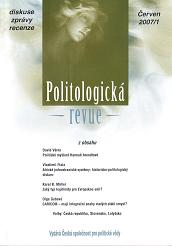Volby 2006 do Poslanecké sněmovny: volební geografie a pět alternativních vysvětlujících modelů
2006 Elections to the Chamber of Deputies of the Czech Republic: electoral geography and five altemative explanatory models
Author(s): Jiří KoubekSubject(s): Politics / Political Sciences
Published by: Česká společnost pro politické vědy
Keywords: Czech Republic; elections; electoral geography
Summary/Abstract: The aim of this study is to analyze the electoral geography of the 2006 Czech parliamentary elections by the means of five explanatory models. They are constructed primarily in relation to the two main parties, Civic Democratic Party (ODS) and Social democrats (ČSSD), which dominated the elections more than ever before. At the end, I will apply - only briefly - all the models to the remaining three parliamentary parties: Communists (KSČM), Christian demoerats (KDUČSL) and Greens (SZ). The first model is led by the centre-periphery perspective. It is, thus, structure-based and tends to perceive interests as objective, given and mainly economic. The leftist vote is identified with the interests of periphery and vice versa. The second model focuses on the role of personalities and campaigns. It points to the subjective, irrational and psychological aspects of electoral struggle. Within this model, the impact of party leaders, both local and central, on electoral geography is studied. The remaining three models involve the historical dimension, although to a different extent. The least historicizing third model follows the course of economic transformation. It corresponds with the first model in being largely economic in outlook. It takes, however, a more subjectivist viewpoint. Two different "waves oj prosperity" are identified as having been a basis for the overwhelming majority of Czech voters' political loyalty. The fourth model looks at an earlier historical period, focusing on the origins of the Czech post-communist party system. The patterns of current electoral geography are perceived as connected with the gradual and interactive process of filling in the "empty political spaces" in the early 90s. The last model goes even further and examines the links between contemporary electoral geography patterns and those of the pre-communist eras. The elections of 1946 and 1907 serve as the comparative basis. Surprising continuity throughout turbulent historical epochs is revealed. These five models are neither exhaustive, nor mutually incompatible instruments of analysis. On the contrary, their complementary use seems preferable. However, keeping them as distinct and analytically separate tools helps us to promote a differentiating approach with respect to each party's specifics.
Journal: Politologická revue
- Issue Year: 13/2007
- Issue No: 1
- Page Range: 97-128
- Page Count: 32
- Language: Czech
- Content File-PDF

